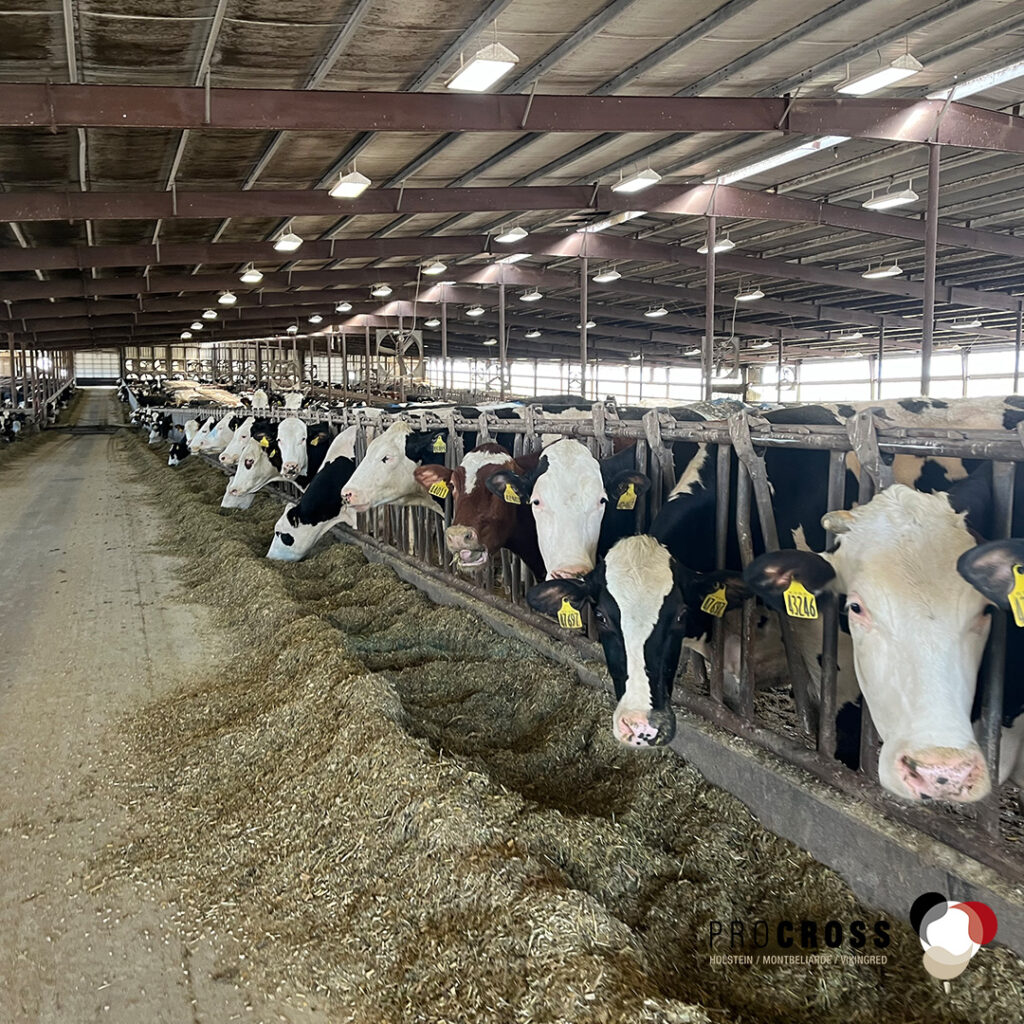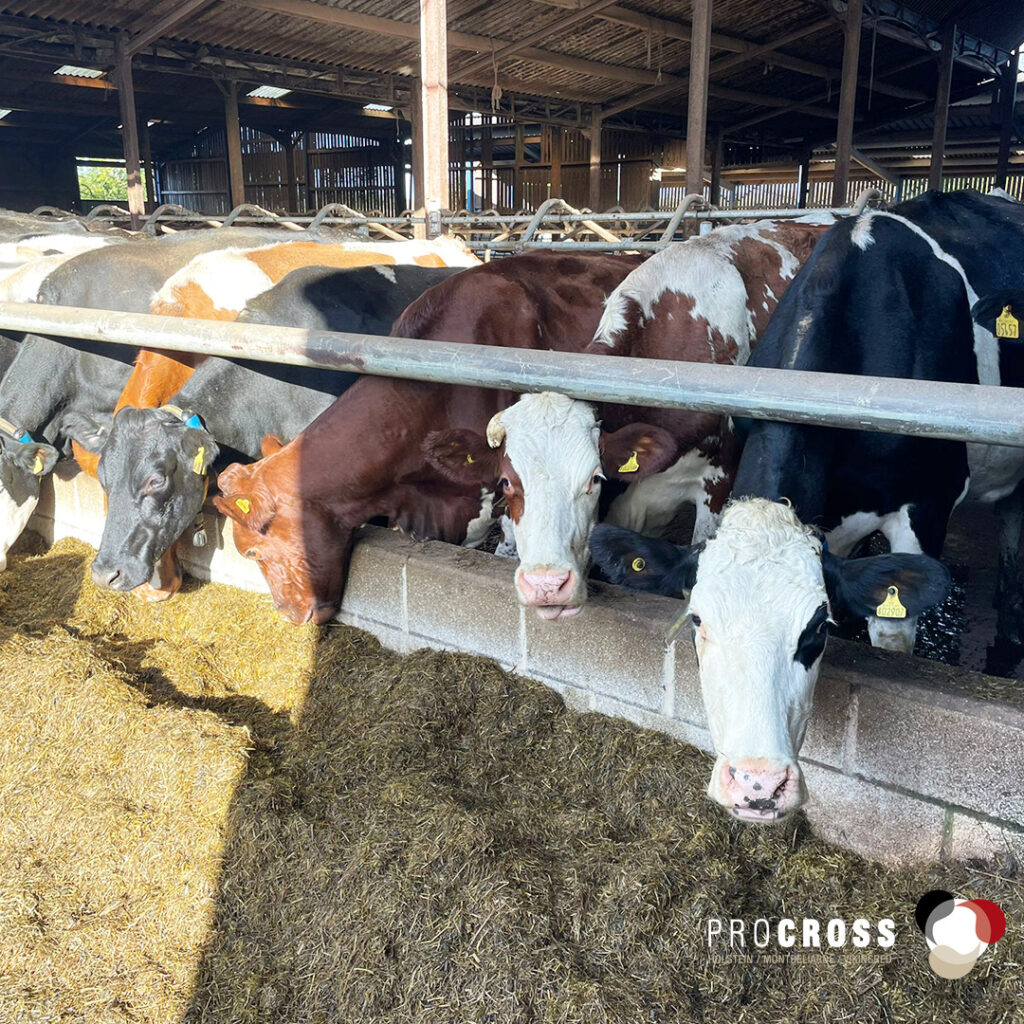
Milk Unlimited Dairy Farms- Kelly Cunningham
ProCROSS boosts health and fertility for American dairy
Three-way crossbreeding with ProCROSS gave Kelly and Christy Cunningham of Iowa, USA, the boost they sought for their dairy herd. They now enjoy healthy, fertile cows without compromising milk yields.
American dairy producer Kelly Cunningham and his wife Christy milk 3,400 ProCROSS cows in Atlantic, Iowa, in the Midwest’s ‘corn belt’.
ProCROSS is a 3-breed rotational crossbreeding system combining VikingHolstein, VikingRed and Coopex Montbéliarde.
They are part of four investors in Milk Unlimited Dairy Farms and are among a growing number of dairy producers milking more than 1,000 cows. In the US, 14% of farms are now milking 1,001-5,000 cows.
“I used to think I was a big dairy, but I’m not a very big fish in the pond any longer. Just last week, a new dairy was announced in the Midwest, with a capacity of 25,000 cows. Units of 12,000 are becoming common every day,” explains Kelly.
Rising build costs don’t appear to deter producers from getting bigger either; pre-COVID build costs averaged $6,000 a cow, but they have since skyrocketed to $10,000 per cow place.
Holsteins are still the largest breed, with an 81% market share compared to crossbreds at 5%. The most popular crossbreed is the Holstein x Jersey, but Kelly and Christy buck that trend, having converted to ProCROSS nearly a decade ago.
Switching to ProCROSS
After their fluid milk processor served notice, Kelly and Christy found a new home for their milk with a cheese maker. This became the catalyst for them to start crossbreeding in favour of higher components.
Cows are housed in sand cubicle sheds, and 65% of the cows – first and second lactation animals – are milked three-times-a-day through a 30/60 double up BouMatic parlour. This is ‘maxed out’ milking 305-310 cows/hour and only turns off for two daily washdowns, taking 40 minutes each time.
The Cunninghams own 1,100 acres and grow exclusively maize. However, they use winter cover crops of oats and no-till cultivation to achieve yields of 24t/acre. Maize silage makes up the bulk of the milking ration alongside purchased alfalfa, soya bean meal, maize grain and cotton seed.
Their milk is sold to Associated Milk Producers in Minnesota. Currently, the price is 39p/litre, but haulage is his third biggest cost at 2p/litre behind feed and labour.
How to breed the best cows
Milk Unlimited operates a three-way breeding programme: VikingHolsteins are bred to Coopex Montbéliarde, and Holstein-Montbéliarde crosses are bred to VikingRed and then back to VikingHolstein.
“ProCROSS is more than just semen; it is a programme. Each of the three breeds has positive aspects,” says Kelly, who aims to breed medium-sized cows with good components, health and longevity. “We have no desire to milk giants. US Holsteins just keep getting bigger, but VikingHolsteins can help me with my height,” he adds.
Kelly does not scrounge on semen costs, with that being “twelfth” on his list of highest costs, saying: “In the grand scheme of things, you can’t save enough on semen to move the needle, so buy the best semen you can buy.”
Currently, heifers are served two times to sexed semen, and 85% of cows are served to Aberdeen Angus.
Elite cows in the top 25% of the herd must have no health issues and give 43kg of milk to be eligible for sexed semen, and even then, they only get one chance.
Different KPIs than the rest
Unlike most all-year-round calving herds, Kelly does not use pregnancy rate as a measure of success. Instead, he prefers to focus on two KPIs: the percentage of cows bred by 150 days and the number of cows not bred by 100 days.
“I want to have less than 20 cows per month not bred by 100 days and 85% of my cows pregnant by 150 days. So, I want 50% of my cows pregnant at any given time or a little bit more. On average, I can get there. On my hotter months, I go a bit below my goal,” he explains.
Kelly is also moving against the grain when it comes to blanket use of hormones. While he said many US farmers use electronic heat detection and double ov-sync as standard breeding practices, he still chalks cows and does not intervene with ov-sync unless cows are not pregnant by 100 days in milk (DIM).
“I want a cow to come into heat on her own, number one. Number two, we have such good reproductive success with ProCROSS that I’m not worried if she gets a little longer in milk,” he says.
Improvements in health and fertility
When comparing data from his Holsteins to the current performance of his ProCROSS cows, Kelly reckons the benefit has been fourfold.
The most noticeable initial improvements were milk components, with fat levels jumping from 3.60% to 4.36% since 2015.
Despite reservations he would take a hit on production, Kelly says energy-corrected milk (ECM) for the first five months of this year averaged 44kg daily.
“Neither one of us thought we would get this kind of milk when we made this switch to ProCROSS. So, we are getting the flow and the components.”
Fresh cow health has improved over time, with Ketosis falling from 4.04% to 1.40%, displaced abomasums lowered from 2.17% to 0.58%, and the cull rate dropped from 40% to 25%.
The future looks bright
The Cunninghams are a ‘hair away’ from breeding all cows to beef in the not-too-distant future if he can lower the cull rate to 20%. Then, dairy replacements will be bred exclusively using virgin heifers.
This will allow him to capitalise on strong beef prices. In fact, he says beef calf sales, along with cull cow sales and milk price hedging, now account for 40% of total income.
His most recent batch of 8,000 calves was sold at 308kg. They cost $930 to grow and yielded a profit of over $1000 a head. “With ProCROSS, we can create higher rear quarter muscling closer to a beef animal,” he says.
Kelly believes the future of dairying in the US is bright and has just invested in a third unit. “I’m in pursuit of more cows as we speak, and I’m evaluating investing in a fourth dairy,” he ends with a smile.
SoMe
Global / UK
ProCROSS = American dairy success 🙌 🧬
Kelly and Christy Cunningham milk 3,400 ProCROSS cows at Milk Unlimited Dairy Farms, in Atlantic, Iowa, USA 🐮 🇺🇸
Kelly aims to breed medium-sized cows with good components, health and longevity. He gets just that with the 3-breed rotational cross of VikingHolstein, VikingRed and Coopex Montbéliarde.
When comparing data from his old purebred American Holsteins with his ProCROSS cows, Kelly reckons the benefit has been fourfold 💰 ❗
Components have significantly increased, with fat levels going from 3.60% to 4.36% at an average of 44kg of ECM per day. Cow health has also improved significantly, and the cull rate dropped from 40% to 25%.
ProCROSS’ medium size is another plus, as Kelly does not want giant cows. “US Holsteins just keep getting bigger, but VikingHolsteins helps me with my height,” he says.
Kelly is keen to tell his peers that they should always buy the best semen they can get, as “in the grand scheme of things, you can’t save enough on semen to move the needle.”
USA
ProCROSS = American dairy success 🙌 🇺🇸
Kelly and Christy Cunningham milk 3,400 ProCROSS cows at Milk Unlimited Dairy Farms in Atlantic, IA, in the Midwest’s Corn Belt.
Kelly aims to breed medium-sized cows with good components, health and longevity. He gets just that with the 3-breed rotational cross of VikingHolstein, VikingRed and Coopex Montbéliarde.
When comparing data from his old purebred American Holsteins with his ProCROSS cows, Kelly reckons the benefit has been fourfold 💰 ❗
Components have significantly increased, with fat levels going from 3.60% to 4.36% at an average of 44kg of ECM per day. Cow health has also improved significantly, and the cull rate dropped from 40% to 25%.
ProCROSS’ medium size is another plus, as Kelly does not want giant cows. “US Holsteins just keep getting bigger, but VikingHolsteins helps me with my height,” he says.
Kelly is keen to tell his peers that they should always buy the best semen they can get, as “in the grand scheme of things, you can’t save enough on semen to move the needle.”

________________________________________________________________________________________________________________
Holtwood Farm- George Ball
A successful start to dairy farming – with tons of ProCROSS help 🐮 ❤
George Ball from Holtwood Farm, near Ashbourne, Derbyshire, has been farming in his own right for just over 4 years.
After researching what breed he wanted for his herd, George decided to pursue ProCROSS crossbreeding. Initially importing 96 in-calf heifers through VikingLivestock for his foundation herd, he is seeing some fantastic results.
George is all about having efficient cows that can produce milk with very high components, as he delivers milk to Joseph Heler Cheese. He is currently averaging 8,600 litres at 4.65 % fat and 3.6% protein, with 4,000 kg being produced from forage – indeed very efficient production!
Having fertile cows is part of George’s breeding goal, as a high conception rate benefits his business. He is currently achieving an impressive 58% in conception rates with dairy X-Vik sexed semen.
George has used many excellent bulls, including VR Vimo, VR Ferman, VR Fuzzy P, and VR Farnam. For the Montbéliarde he has used Pactole, Ourasi, and Malpuech.
This year is the first year he has used VikingBeef Y-Vik sexed semen for beef-on-dairy production. Danish Blue bulls like Orakkel and Picasso help him profit from every cow with easy-calving calves.

________________________________________________________________________________________________________________
The ProCROSS Experience: Clover Hill Dairy, Wisconsin
Clover Hill Dairy is a 5th generation family farm owned and operated by the Bonlender family in Wisconsin. Their success with ProCROSS started in 2005. Today, their lactating herd includes 2,100 cows with a production average of 87 pounds of ECM and 4.4% fat, 3.3% protein.
“With our ProCROSS cows we experienced cutting 50% down mastitis, placenta retention, twisted stomach, feet diseases and stillbirth” – La Corte Herd, Italy, Manager Carmelo Monteleone.
“Once you get the ProCROSS cow it will be the best cow you ever milked” – ProCross pioneer, Mike Osmundson.
“If you want to make money in the global genetic business, you have to be up front in the Holstein genomic race. But in commercial dairy production the Holsteins can not compete with ProCROSS cows”.
“The ProCROSS heifers are easy to manage. They are trouble-free and their tolerance to our extreme weather conditions is good” – Ben Andersen, Idaho, USA
What I really like about the ProCROSSes is the tremendous feet & legs. They have super locomotion and much less lameless”.
“Everything regarding mastitis, somatic cells, still born, cull rate, have improved with crossbreeding”.
“A few minutes after birth, the calves search avidly for the mothers udders to suck, which the Holsteins rarely do. The crossbred calves are much more vigorous. When we enter in the calves stable we notice that they are the ones that run and jump more, and above all, they are the ones that are in better body condition” – Alexandre Arriaga, Sabugo, Portugal.
“Crossbreeding really gave us a big advantage” Kurt Hoeksta, Oakdale, California, USA.
“The results of my ProCROSS cows realy suprised me. More milk, better fertility, lower SCC and cows that have fewer problems to attend to. ProCROSS improved our quality of life” – Anton Verschuren, Oploo, the Netherlands.
“Last year we got 90 percent of our springmating herd in calf in 10 weeks thanks to hybrid vigor in our crossbred cows” – Mike Green, Australia.
